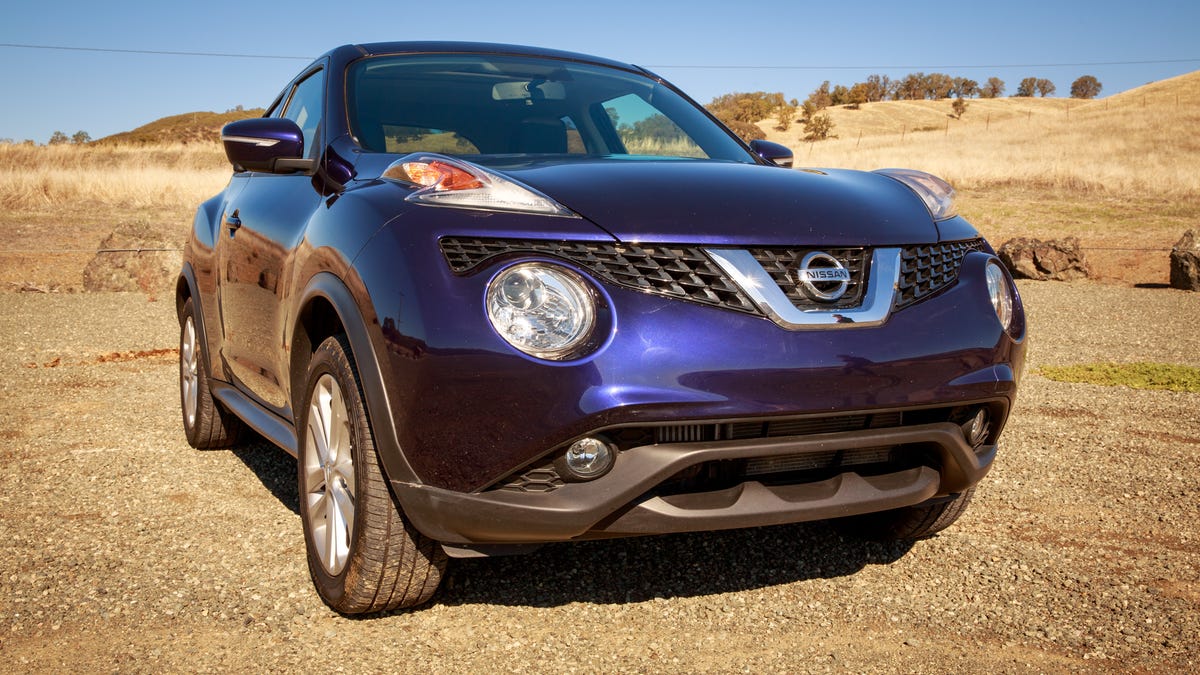The 2015 Nissan Juke is quirky both inside and out (pictures)
Since 2011 the Nissan Juke has been inspiring both cheers and jeers thanks to its take-it-or-leave-it design. In 2015 the Juke gets projector-beam headlamps, a whole slew of color choices and Nissan's Around View monitor.

The Juke is not for everyone. The round headlights are completely separate from the turn signals above them. The front fascia is loud and proud and commands attention.
Love it or hate it, the design team over at Nissan deserves credit for making bold choices on the front fascia.
From the front the Nissan Juke is unlike anything on the road.
The taillights are placed high on the rear fascia, giving the Juke a crouched stance.
Flaring rear fenders contribute to the distinct Juke design.
The Juke has the appearance of a two-door, thanks to rear door handles that are flush with the body.
While the Juke doesn't have the largest amount of cargo space in the segment, it still nets a respectable 35.9 cubic feet of space with the rear seats folded down.
The taillights take their cue from Nissan's 370Z model, adding a bit of sporty flare to the funky rear end.
The 370Z inspiration continues in the front with the distinctly designed turn signals.
The Nissan Color Studio allows for customizable colors throughout. The interior features options for trim and center console and customers are able to choose from multiple colors applied to nine exterior trim pieces like side mirror caps and front and rear bumpers.
The hidden rear door handles on the Nissan Juke bring a streamlined look to the back half of the car.
The Juke gets power to the road via a continuously variable transmission (CVT). Although CVTs have a reputation of producing a high-pitched whine, the one installed here gets the job done relatively quietly. Throwing the gear lever to the left puts the transmission in a shiftable mode, dividing the CVT into seven steps. It's a nice way of imitating a more conventional automatic.
The Juke has a good amount of standard features, including the power sun roof. Also on tap are heated front seats, push-button ignition, Bluetooth, satellite radio and hands-free text messaging assistant.
The Juke SL comes with a 5.8-inch color touchscreen as well as a smaller screen below for climate control and drive mode information. However, the touchscreen is small when compared with other quirky utes like the Kia Soul or the funky Hyundai Veloster hatchback.
The all-wheel-drive system in the Juke can deliver up to 50 percent of available power to the rear wheels. The torque vectoring system can then deliver all of that torque to either one of the rear wheels.
The Juke is full of quirky touches like these round door handles. The car is standout in a world of bland design choices in today's market.
Located directly behind the cup holders, the heated seat buttons are often difficult to access. The problem is compounded when the flip-up armrest is folded down. There is room for the buttons on the center stack, making their current location very frustrating.
When D-Mode is selected the smaller screen displays options for driving, such as normal, sport and eco. Select the Climate button and a new set of options are displayed.
When the Climate button is selected, the options switch to air conditioning and heating controls. It's a neat trick, saving room on the dash, which make the position of the heated seat controls even more puzzling.
In addition to a backup camera, the Juke employs Nissan's around-view monitor, providing a bird's-eye view of the vehicle.
The 5.8-inch color touchscreen isn't large enough to accommodate all the necessary information. The navigation system is quick to respond, but the interface is crowded and difficult to read.
The 1.6-liter four-cylinder engine gets plenty of pep with a turbo charger. It's not the fastest thing on four wheels, but it maneuvers quickly through city traffic and is willing to have some fun on the back roads.

